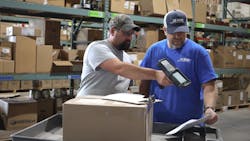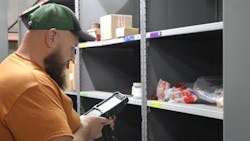Turning the tide on warehouse inefficiencies for long-term success
At LB Water’s warehouse in Stoneboro, Pennsylvania, location manager Tyler Novak faced a significant challenge. The distributor of waterworks infrastructure products maintained a large inventory but struggled with its warehouse management system (WMS), which hampered efficiency and inventory integrity.
“Our old system lacked the ability to pull material from the bin you wanted,” Novak said. “As soon as you printed the pull ticket, it allocated the bin, which was essentially written in stone. You couldn’t take the item from somewhere else, even though we have a number of different bins with the same materials in them.
“If someone needed a fitting and took it off the shelf right in front of them but it wasn’t from the assigned bin, it would mess up your bin integrity,” Novak continued.
“That was just not the way we worked our business,” said Brian Shirk, LB Water CIO. “There was no flexibility.”
Recognizing the need for modernization
LB Water prides itself on providing high-quality service for more than 50 years, specializing in water, wastewater, and stormwater solutions. Founded in 1970 in Selinsgrove, Pennsylvania, the company now boasts more than 200 employees across 10 locations in Pennsylvania, Maryland and Virginia. A robust product inventory complements LB Water’s industry expertise, ensuring it effectively meets customer needs.
To maintain top-rate service, the company needed to modernize its WMS. Novak consulted his warehouse team for feedback about the existing system and everyone agreed that a change was necessary.
“I asked them one final question, ‘Is it working?’ And each person said, ‘No,’” Novak recalled.
This prompted a call to Shirk, signaling the urgent need for improvement.
“We needed to come up with something better,” Novak said.
The search for a new WMS led them to Epicor’s annual conference for the Prophet 21 World Wide User Group, where they learned about Latitude WMS.
Securing executive buy-in
Identifying the new WMS was only part of the battle. Shirk managed the company’s WMS initiative, and for years tried to advance the project. He found an ally in Novak, though a new WMS was a tough sell to upper management.
However, the pain points were real. Shirk noted that in LB Water’s annual physical inventory (PI) counts, approximately 20% of the products being counted were typically off, which affected the company’s bottom line. Reducing this number was a priority across the company.
Shirk also knew the potential benefits were undeniable and the likelihood of success was high. “Our leadership team trusted that we would make this project work,” he said. “You’ve got to have the trust of upper management that you will see a project like this succeed.”
Piloting the WMS implementation at Stoneboro
LB Water piloted the warehouse management system at its Stoneboro warehouse, with Novak, Shirk, and the IT team customizing the system to its needs. The PathGuide team customized serial number tracking and other modifications, coaching the LB Water team on how the WMS would alter longstanding processes. Novak admitted that changing established processes wasn’t easy.
“One of the biggest challenges with an implementation like this is changing how people have always done something,” Novak said. “But with the new system, you no longer need to do those things.”
Novak quickly saw the benefits warehouse management software could deliver. The day its WMS went live in Stoneboro, he had a new employee start, which he saw as an opportunity to test the new system.
“I gave him an order to pull and said, ‘Here’s the handheld scanner, here’s the map of the warehouse — go pull it.’ And he brought back all the right items that day,” Novak recalled, noting that such a feat typically required weeks or months of training and learning hundreds of product codes. “I could never have attempted that prior to having a WMS. I thought, ‘Wow, this is a gamechanger.’ On day one, you have an effective employee.”
Over the course of 18 months, Stoneboro saw significant efficiency gains. In the warehouse’s PI count, Novak said only 32 items of the 3,800 items needed adjusting, or less than 1%.
Company leadership soon noticed. After a board member saw a demo of the warehouse management solution at Stoneboro and the resulting increased efficiency, a mandate quickly followed to have the WMS at each of its locations.
Overcoming resistance from warehouse personnel
While the benefits from using WMS software were clear to upper management, Novak anticipated some pushback from LB Water’s warehouse managers. Before the broad rollout, he visited each location to show the warehouse manager how the new system worked.
Novak brought unique insight to these visits, having served as a warehouse manager before becoming Stoneboro’s location manager.
“I felt like the WMS hype man,” Novak said. “I was there saying, ‘Guys, this is how it works.’ And they were pushing back and throwing questions at me. I'd say, ‘Listen, this is what it's going to do,’ and explain the reasons why.
“It helped that I previously worked as a warehouse manager because I knew exactly what each warehouse manager is doing day-to-day,” he continued. “The one thing I told them all is, ‘I’m not going to bring you something unless I know it will work.’”
Initially, warehouse managers met the warehouse management system implementation with skepticism. However, as each location became operational, the tide started to shift. LB Water rolled out the new WMS in phases, training employees on handheld RF terminals and using a test system to process orders.
Novak championed the new system throughout the process. Before each new location went live, a couple employees would travel to Stoneboro to onboard with Novak and gain hands-on experience.
“If we didn’t have Tyler fight through the barriers that he did, it would have been a much harder process,” said Jared Young, IT Specialist at LB Water.
Empowering workers and driving new levels of success
LB Water has since deployed the WMS at nine of its 10 locations, with implementation plans for the tenth location in the works. The company has seen notable increases in efficiency and improved inventory management.
The system empowers warehouse workers to operate more rapidly and effectively. Thanks to its intuitive usability, new workers are onboarded quickly, requiring less training time and bringing immediate value to the operation. The company can easily reallocate employees to different locations, as they already have the tools needed to thrive.
Before using a WMS, annual PIs typically extended over a two-day period, with each warehouse calling in extra help from other locations. Successful recounts at the end of day one were a win, as was nearing projected dollar totals at the end of day two.
With a warehouse management system, Shirk and Novak’s team started inventory at 7:30 a.m. and finished by 10:30 a.m. that same day, with no reserves from other warehouses. Only 31 items needed adjustment.
Novak was so confident in the WMS’ efficacy that he also scheduled three additional work meetings that day, something unthinkable on prior inventory days.
“I still got home on time,” Novak said. “I left at 5 p.m. and told my wife, ‘I can’t believe we did inventory today, had all these meetings, and everything stayed on schedule.’”
Eliminating the need for physical counts
While LB Water has achieved significant gains with its WMS project, the work is far from complete. After the tenth warehouse goes live, Shirk’s ultimate goal is to transition each location to cycle counting and eliminate the need for annual PIs. While he understands the current need for them, they are time-consuming and inefficient. Shirk has witnessed the warehouse management solution’s capabilities and believes this transition will happen over time.
“I think we'll get there,” Shirk said. “Once we can prove to the auditors that our cycle counts are consistently 95-98% error-free, that we counted through the entire inventory and aren’t skipping stuff, that’ll come to play.”
Shirk notes the attitude shift among the warehouse workers who initially resisted the new WMS. One warehouse manager, in particular, epitomized this change.
“He was convinced, ‘We don’t need this system; I have this under control,’” Shirk said. “But now, after seeing and working with it, it’s amazing to watch his mindset change to, ‘Man, this really works well.’”
Those same skeptics who once insisted they had it under control now effortlessly pick up handheld devices and “head out to the warehouse because now they can find what they need,” Shirk added.
The transformation is undeniable, laying a pipeline to efficiency as LB Water continues to achieve inventory integrity with confidence.
About the Author
Eric Allais
Eric Allais is president and CEO at PathGuide Technologies.



